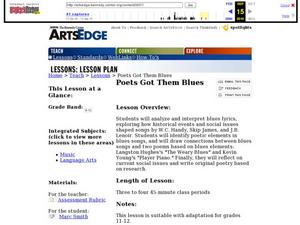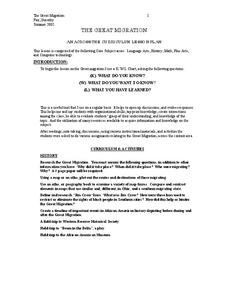Curated OER
US Civil Rights Movement: Beginnings through the 60s
A real find for a U.S. History teacher, this presentation could supplement many class sessions about the Civil Rights Movement. Pictures of events, major figures, and "Whites Only" signs are striking and effective for even your most...
Center for History and New Media
Growing Up in a Segregated Society, 1880s–1930s
What did segregation look like in the beginning of the 20th century? Middle and high schoolers view images of segregated areas, read passages by Booker T. Washington and W.E.B. DuBois, and come to conclusions about how the influence of...
Curated OER
Segregated America
Students investigate Jim Crow laws. In this segregation lesson, students analyze images that display American segregation. Students use the provided questions to aid them in their evaluation of the images.
Alabama Department of Archives and History
W.E.B. DuBois, Booker T. Washington, and Jim Crow
Class members use the think-pair-share strategy to compare the views of W.E.B. Du Bois and Booker T. Washington and to consider how each man's backgrounds influenced his philosophy.
Alabama Department of Archives and History
"Scottsboro Boys": A Trial Which Defined an Age
Here's a must-have resource. Whether your focus is racism, the Great Depression, the "Scottsboro Boys" trial, or part of a reading of To Kill A Mockingbird, the information contained in the seven-page packet will save hours of research...
Curated OER
John Gary Evans and the Politics of Race
Students read letters written by Evans and Gunton regarding race relations. In this Progressive Movement lesson, students interpret the intentions and tone of the letters to understand contemporary racial beliefs. Students discuss the...
American Institute of Physics
Physicist Activist: Dr. Elmer Imes and the Civil Rights Case of Juliette Derricotte
Elmer Imes was not only a brilliant physicist but also a civil rights activist. After an introductory lecture, groups read two articles about a traffic accident that killed one Fisk University student and injured several others. The...
American Institute of Physics
Historical Detective: Edward Alexander Bouchet and the Washington-Du Bois Debate over African-American Education
Young scientists meet Edward Alexander Bouchet who, in 1876, was the first African American to receive a PhD in Physics. This two-part lesson first looks at the debate between Booker T. Washington and W.E.B. Du Bois about the type of...
Curated OER
Perseverance
Young scholars examine how the failure of Reconstruction led to the systematic passage of Jim Crow laws in states across the South and the negative impact these laws had on the growth and development of the US.
Center for History and New Media
The Daily Experience of the Laurel Grove School, 1925
What was daily life like for those attending segregated schools in 1925? Modern learners fill out a KWHL chart as they explore historical background and primary source documents about the Laurel Grove School in Fairfax County, Virginia....
PBS
George Washington Carver: Scientist, Inventor, and Teacher
Using video clips along with primary and secondary documents, scholars analyze the life of George Washington Carver, one of America's best scientists and inventors. Class members then create music, posters, and skits about this amazing...
Curated OER
Separate is Not Equal: Brown v. Board of Education
Students analyze photographs that feature segregation. In this human rights lesson, students examine photographs of a segregated movie theater, a Ku Klux Klan gathering, a segregated business sign, and an illustration from "Harper's...
PBS
Booker T. Washington: Orator, Teacher, and Advisor
Imagine teaching yourself to read and write—do you think you could do it? Scholars analyze how Booker T. Washington went from a slave learning to read to a leading educator in the United States. Using video clips, speeches, and primary...
Facing History and Ourselves
The Legacies of Reconstruction
The final instructional activity in the seven-resource Reconstruction Era collection examines the legacies of Reconstruction. Class members investigate why the period has been called an "unfinished revolution," "a splendid failure," and...
Curated OER
Using and Creating Timelines
Eleventh graders analyze information presented in a timeline and then create a time line. They put the following events in order from oldest to recent: Telephone invented (1876), Massacre at Wounded Knee (1890), First transcontinental...
Curated OER
Poets Got Them Blues
Contemplate what music learners listen to and why they listen. Can they find poetry within music lyrics? Specifically hone in on blues lyrics and ruminate upon the social issues prevalent in the themes. Particular song lyrics coincide...
Curated OER
New Kent School and the George W. Watkins School:
Students research the U.S. Supreme Court case that forced the integration of public schools and meet the individuals who experienced segregation, fought to dismantle the institution, and integrated the public school system of New Kent...
Orlando Shakes
The Best of Enemies
History comes to life with the play The Best of Enemie. Scholars learn literary elements as well explore racial issues in American history. The play is based on a true story and addresses the universal truth that people are capable of...
Curated OER
The Harlem Renaissance Movement and its Music
Harlem Renaissance lesson plans can bring the music, poetry, and literature of this time period alive.
Curated OER
The Great Migration
Students research the Great Migration and answer questions to discover where it took place, when it took place, who were migrating, and why in a 2 page paper. They use a map or atlas to plot out the routes and destinations of those...
Curated OER
African Americans in World War I - Lesson Two
Learners explore the decision to allow African Americans enlist in the military. In teams of three to four, students debate allowing Muslim Americans to enlist in the war. Learners not participating in the debate serve as legislatures....
Curated OER
Crisis in the Classroom: Little Rock & Boston
Students examine periods and instances of racial disharmony in the aftermath of segregation in the South, and de facto segregation in the North. They analyze causes of antagonism between racial groups and explore possible solutions.
Other
Jim Crow Museum of Racist Memorabilia: What Was Jim Crow?
A listing of the Jim Crow laws and understood Jim Crow etiquette found across the South in the late 19th century.
Independence Hall Association
U.s. History: w.e.b. Du Bois
Read a brief biography of W.E.B. DuBois, who was an early civil rights activist and supporter of equal opportunity and treatment for African-Americans. See how he acted on his beliefs. Included is a brief quiz about the Progressive Era.

























